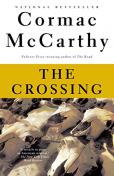BKMT READING GUIDES
The Crossing
by Cormac McCarthy
Unknown Binding : 426 pages
1 club reading this now
0 members have read this book
In the late 1930s, ...
Introduction
In The Crossing, Cormac McCarthy fulfills the promise of All the Pretty Horses and at the same time give us a work that is darker and more visionary, a novel with the unstoppable momentum of a classic western and the elegaic power of a lost American myth.
In the late 1930s, sixteen-year-old Billy Parham captures a she-wolf that has been marauding his family's ranch. But instead of killing it, he decides to take it back to the mountains of Mexico. With that crossing, he begins an arduous and often dreamlike journey into a country where men meet ghosts and violence strikes as suddenly as heat-lightning--a world where there is no order "save that which death has put there."
An essential novel by any measure, The Crossing is luminous and appalling, a book that touches, stops, and starts the heart and mind at once.
The opening section of The Crossing, book two of the Border Trilogy, features perhaps the most perfectly realized storytelling of Cormac McCarthy's celebrated career. Like All the Pretty Horses, this volume opens with a teenager's decision to slip away from his family's ranch into Mexico. In this case, the boy is Billy Parham, and the catalyst for his trip is a wolf he and his father have trapped, but that Billy finds himself unwilling to shoot. His plan is to set the animal loose down south instead.
This is a McCarthy novel, not Old Yeller, and so Billy's trek inevitably becomes more ominous than sweet. It boasts some chilling meditations on the simple ferocity McCarthy sees as necessary for all creatures who aim to continue living. But Billy is McCarthy's most loving--and therefore damageable--character, and his story has its own haunted melancholy.
Billy eventually returns to his ranch. Then, finding himself and his world changed, he returns to Mexico with his younger brother, and the book begins meandering. Though full of hypnotically barren landscapes and McCarthy's trademark western-gothic imagery (like the soldier who sucks eyes from sockets), these latter stages become tedious at times, thanks partly to the female characters, who exist solely as ghosts to haunt the men.
But that opening is glorious, and the whole book finally transcends its shortcomings to achieve a grim and poignant grandeur. --Glen Hirshberg
Discussion Questions
No discussion questions at this time.Book Club Recommendations
Recommended to book clubs by 0 of 0 members.
Book Club HQ to over 90,000+ book clubs and ready to welcome yours.
Get free weekly updates on top club picks, book giveaways, author events and more








